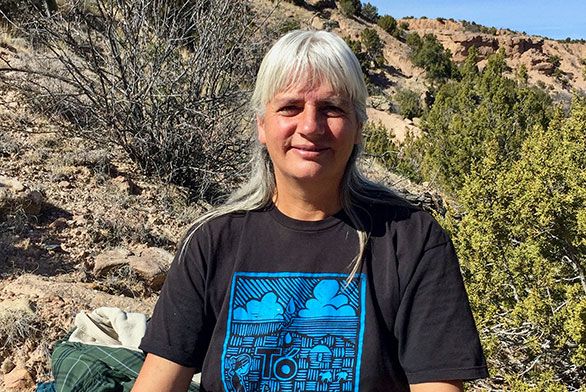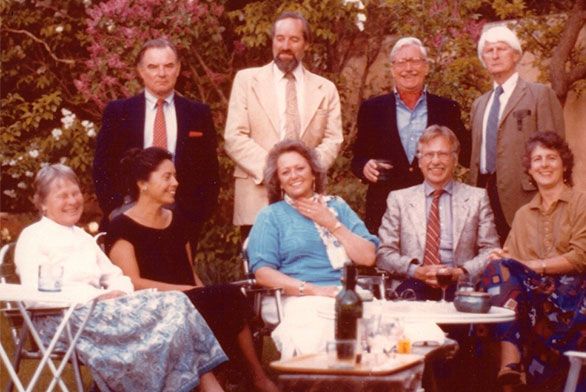The Art of Home: Inside Athena Steen’s (SF83) Canelo Project
February 13, 2024 | By Jennifer Levin
Clay is simple yet infinitely complex. It’s dug from the ground and can be shaped into utilitarian objects—pots and bowls in which to prepare and eat food, carry water, and mix medicine. Combine it with other natural materials, and you can create shelter. And with a few final additions, you can build a beautiful home from plant fibers and clay with your own hands—no prior experience necessary.

“You don’t need to be an expert. You can train someone who’s never done it before to go home and try. Of course, you’re going to learn more as you do it. That’s the amazing thing about these materials. The more you know, the more there is to learn,” says Athena Steen (SF83), who runs the Canelo Project in Elgin, Arizona. She and her husband Bill founded the nonprofit educational organization and family homestead in 1989 to teach people how to build strawbale homes plastered with clay. Today, her grown sons and their spouses also work at Canelo, and Steen teaches their building methods around the world.
Steen grew up in Santa Fe, a member of Santa Clara Pueblo. Her mother was the well-known sculptor and architect Rina Swentzell, and her father was beloved St. John’s tutor Ralph Swentzell. Both have passed, but their wisdom lives on in Steen. She followed in her mother’s footsteps as a home designer working with earthen materials. And she became an educator like her father. As a child, she was often frustrated by his methodical thinking and how, if you asked him a question, the answer could last for hours. She admits she attended St. John’s because it was an inexpensive choice for her as the daughter of a faculty member—and although she appreciated the St. John’s Program and the books she was reading, she was too shy to speak much in seminar. The stars didn’t align until senior year when she landed in her dad’s class.

“Those attributes that I couldn’t stand as a child are what made him the best teacher I ever had,” she says. “He would come to class with pure enthusiasm. He would drum up all sorts of excitement and take you for this ride, and he left no one behind. He didn’t go flying off to the moon with two or three students. He kept everyone in the bubble. He was amazing. I understood how important teaching was. And now, I love teaching.”
At Canelo, Steen and her family teach workshops on straw bale building, natural plasters, earthen floors, and timber framing to beginners, experienced buildings, and every level in-between. What unites them is their eagerness to be there and get their hands in the clay. Straw bale and clay create walls of natural insulation that are several inches thick. The homes have a fortress-like solidity, and they stay warm in the winter and cool in the summer, with far fewer temperature fluctuations than in adobe construction, which often needs to be fortified with metal wire and commercial insulation.
Steen’s all-natural clay plaster method is different from that of other builders in two ways. First, she mixes a great deal of plant fiber into the clay, which means it can be slathered in thick layers without cracking. And the fiber does not have to be straw. “It can be prairie grass, crushed pinecones, rice hulls, agave stock—whatever’s available,” she says.
Second, Steen likes to turn walls into works of art. “We all crave something different than a sterile box. You can curve and shape the walls,” she explains. Steen comes from a large family of legendary clay artists, which explains why her buildings fall on an aesthetic spectrum that evokes architect Antoni Gaudí’s ornate and mystical works in Barcelona. Steen molds shelves, niches, banquettes, and fireplaces out of clay and fiber, embeds stones and other decorative elements into the plaster, and creates animal and sun forms on exterior walls. Colors are often bold and bright, inspired by works she completed in Mexico early in her career.
As experienced as Steen is with clay plaster, she discovers a new facet every time she travels for an international workshop. Each clay soil is different, and clay dug fresh from the ground changes from year to year. Some of the hardest, siltiest clay can be found in New Mexico and Colorado. Silt can make a plaster weaker, causing it to run in the rain or release dust when touched, so one must add a stronger clay to it. But sometimes the materials play tricks on you. In Costa Rica, for instance, the region’s hard clay behaved unusually with water. “It wouldn’t feel sticky, so we kept adding more clay,” she recalls. “But then it would crack on the wall, which is a sign that it’s too much clay and needs to be watered down. So, it wasn’t sticky, but it was extremely expansive.”
Another learning experience came when they built an earthen fireplace and it cracked. When preparing to redo the work, Steen consulted her aunt, the potter Dolly Naranjo, who suggested adding pumice to the mix instead of sand; it’s volcanic and can take heat. Problem solved, Steen says: “Twenty years later, it still hasn’t cracked.”
Like adobe, clay-plastered strawbale must be maintained. You can coat the walls with clay paint every three years—allowing you to easily and frequently change the colors of your house—and the structure will remain in great condition. Or let it go for a couple of decades, and the bottoms of the walls will start showing their fibers. “They can get a little hairy looking, down at the bottom, especially outside,” Steen says.
But the fix is to mix more clay plaster and smooth it on. “It’s so simple and magical,” Steen says. “You can take this substance from the ground and turn it into a place to live. Its ‘sculptability’ is out of this world—and it’s forgiving. If you don’t like it, you can keep changing it.”

